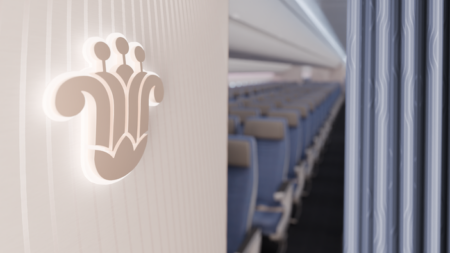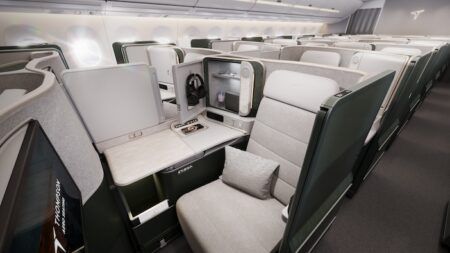Deutsche Lufthansa AG is already a well-respected airline, but it has now set itself the task of becoming the benchmark carrier in the aviation sector. The company has unveiled an range of actions it has set out in order to achieve this goal, in order to derive greater benefit from the continued growth of the global air transport market. These actions include creating new platforms and products for both intercontinental and European air services, an intensified partnership with Air China, an even stronger focus on quality and innovation, and a group-wide drive to create more efficient structures and processes.
“The global market for air transport continues to grow,” stated Carsten Spohr, CEO of Deutsche Lufthansa (pictured left). “But in the dynamic and highly price-sensitive market segments, our current platforms only enable us to exploit the growth potential to a limited extent, in view of their sometimes over-rigid cost structures. That’s why we are now seeking to tap new growth areas, by creatively and innovatively refining our products and services in both the airline sector and – especially – related markets. By 2020 we aim to have raised our revenues from our new businesses, our new platforms and our service companies from the present 30% to 40% of our total revenue flow.
“We don’t want to be driven by change in the aviation sector: we want to be among the drivers of it,” Spohr continued. “But doing so demands bold steps forward: our market is no place for half-measures. The Lufthansa Group has often set our industry’s standards in the past. And I see no reason why we shouldn’t do so in the future. After all, we have the best of foundations for achieving this: we are a widely diversified aviation group with strong brands; we have a very loyal customer base; and we can count on highly qualified employees who are the envy of our competitors.
“Our current SCORE program has also equipped us with an ability to change,” Spohr stated. “And we now aim to use this to forge our corporate future.” The work here has involved defining seven ‘action areas’ – not only in the marketplace but also in terms of its internal structures and processes – which should enable the Group to make fuller and more fruitful use of its combined strengths and resources. Priority is also being given within these action areas to the Group’s new growth concepts and to the key issues of innovation and quality, though improving its competitive credentials also remains high on the agenda.
“The fundamental SCORE notion of continuously reducing our unit costs must remain equally valid when the programme ends as scheduled in 2015,” Spohr emphasised. “And to that end, we will be making this a permanent group-wide concern. We must constantly generate new ideas to improve our profitability, sharpen our competitive edge and keep us the first choice for our customers.”
New growth concepts
The Lufthansa Group will be establishing new platforms with competitive cost structures to ensure that it derives maximum benefit from the further growth of the aviation sector. Thus, the Group’s present multi-brand system with its multiple hubs of Frankfurt, Munich, Zurich, Vienna and Brussels will now be complemented by the new ‘Wings’ multi-platform concept in all the Group’s European home markets. The new Wings family, which will build on the success of the Germanwings concept, will be specifically aligned to the high-growth market for private air travel. The Group will use the new Wings master brand to bundle the various platforms for its point-to-point air travel business; and it is considering extending the concept to intercontinental services, too.
Amalgamating the European members of the Wings family – a move which will also include Germanwings – will permit an aligned management of all these operations. With Germanwings Lufthansa will also complete the planned transfer of all of its routes not serving its Frankfurt or Munich hubs by next spring. The Germanwings fleet will also be further enlarged to up to 60 aircraft.
With Eurowings as its starting platform, the Lufthansa Group will develop a competitive European air travel product for continental travel. Since the competitive cost structures required cannot be achieved with the present fleet of Bombardier CRJ aircraft, these will be replaced with Airbus A320s. Eurowings will operate up to 23 A320s, and its services are set to be launched in spring 2015. The first Eurowings base outside Germany will be in Basel, Switzerland, and will have a fleet of an additional two to four A320s. It should commence operations early next year.
The Lufthansa Group also plans to create a competitive new long-haul platform under the Wings banner for the price-sensitive segment of private travel. Studies are currently being conducted into whether this should be done alone or with a further partner: for the latter option, talks are already at an advanced stage with Turkish Airlines. In an initial phase, the new intercontinental platform is expected to operate with a fleet that will gradually be built up to seven Boeing 767 or Airbus A330 aircraft, with operations likely to commence in winter 2015.
In a further move, Lufthansa Passenger Airlines is considering to what extent up to nine of its Airbus A340s could be operated at substantially lower unit costs, either on new routes or on routes currently threatened with closure. Negotiations are underway with all the internal and external stakeholders involved to achieve the cost reductions required. Ultimately, the extent to which these new platforms and formats can be developed in the longer term will depend on their profitability and their market success.
Elsewhere, Lufthansa is working intensively to further develop its bilateral partnerships with other air carriers. In this connection it has just concluded a new agreement with Star Alliance partner Air China for closer collaboration on the MRO and passenger services fronts and, ultimately, a joint-venture arrangement. It is Lufthansa’s declared objective to offer its customers in the four biggest markets and economies outside its home markets the best product available, in collaboration with its local partners.
As a unique aviation group, the Lufthansa Group will also be devoting sizeable resources to further developing its various service companies. Lufthansa Technik and LSG Sky Chefs are also benefiting from the expansions of numerous Lufthansa competitors, especially the Gulf-based carriers, and thus serve as a natural “hedge” in the global competitive landscape, according to Lufthansa.
Lufthansa Technik and LSG Sky Chefs will be investing in expanding their business, with a focus on Asia and the Americas. LSG Sky Chefs also aims to increase its involvement in related markets beyond the aviation sector, such as the rail catering segment. Miles & More, too, is seen to offer “significant” further growth potential; and the Lufthansa Group’s customer loyalty programme will now be refined to enhance its appeal to “less frequent flyers”, and also to offer more mileage earning and redemption options.
Quality and innovation
CEO Carsten Spohr will bear direct responsibility for the Group’s planned innovation and quality drive. Lufthansa intends to invest a total of €500m in innovations group-wide between now and 2020. The plans here should see a new “innovation hub” established this year in Berlin, closer to the start-up and digital technology scene; and an “innovation fund” will also be set up to expedite the development of promising new ideas from both within and outside the Group.
Lufthansa not only wants to become the first “five-star carrier” in the Western Hemisphere; it also aims to achieve quality leadership in all its various markets. The quality drive here will include bringing greater personalisation to its products and services, with the aim of tripling the present revenues from its additional services between now and 2020.
Outlook
Despite the investments that the raft of actions announced will entail, the Lufthansa Group remains confident of its revised business projections for 2014 and 2015. The Executive Board expects to report an operating profit of around €1bn for the current year, or €1.3bn after adjustments for one-off effects.
A series of structural actions will need to be taken soon, however, if the financial goals for 2014 and 2015 are to be achieved. Thus, Lufthansa Passenger Airlines will reduce its 2014 available-seat-kilometer capacity growth by over 50% compared to original plans, and will be withdrawing five aircraft from its European network and three from its intercontinental routes in the 2014/15 winter timetable period. Lufthansa Cargo’s capacity will also be reduced this winter through the withdrawal of two Boeing MD-11 freighters.
The Lufthansa Executive Board says it is confident that the raft of actions planned will go a long way towards securing the Lufthansa Group’s continued viability and further success.




